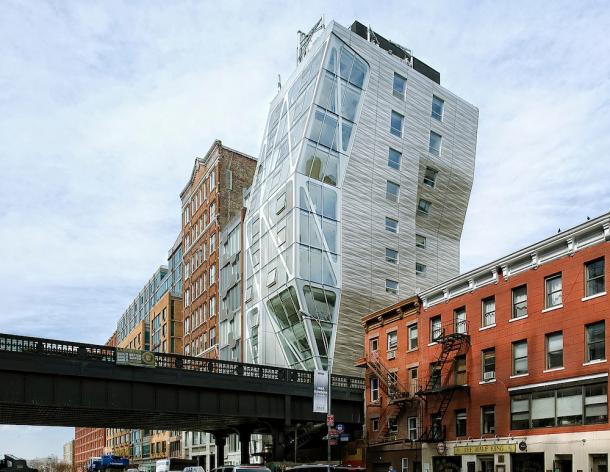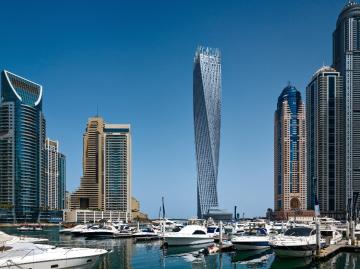The world's tallest twisting tower and the rise of augmented reality technology in construction were among the 10 most popular articles posted on Building Design+Construction's website, BDCnetwork.com, in 2013. Here's a roundup of the top articles from the past 12 months. Happy New Year from the BD+C editorial team!
1. 2013 Giants 300 Report
Building Design+Construction's annual ranking the nation's largest architecture, engineering, and construction firms in the U.S. Read the article.
2. 8 trends shaping today’s senior housing
The ranks of those age 65 and older are swelling by the thousands every day. Is there an opportunity for your firm in the seniors housing market? Read the article.
3. World's tallest twisting tower added to Dubai skyline [slideshow]
The 75-story residential building, designed by SOM, features a dramatically rising helix shape for a distinctive addition to the city’s skyline. Read the article.
4. Meet BD+C's 40 Under 40 class of 2013
Forty individuals who have distinguished themselves by their career achievements, service to their professions and communities, and active participation in charitable work. Read the article.
5. 13 structural steel buildings that dazzle
We profile the 13 structural steel building projects have earned national recognition in the 2013 Innovative Design in Engineering and Architecture with Structural Steel awards program (IDEAS2). Read the article.
6. 7 hip high-rise developments on the drawing board
Here's a collection of recently profiled high-rise projects in the works around the world. They include Adrian Smith and Gordon Gill's whimsical Dancing Dragons tower in Seoul and a 1,312-foot-tall finance and trade center under construction in Nanning, China. Read the article.
7. 5 innovations in high-rise building design
KONE's carbon-fiber hoisting technology is among the breakthroughs named 2013 Innovation Award winners by the Council on Tall Buildings and Urban Habitat. Read the article.
8. Augmented reality goes mainstream: 12 applications for design and construction firms
Thanks to inexpensive mobile devices and increasingly advanced software apps, Building Teams are finally able to bring their BIM models to life on the job site. Read the article.
9. In an era of mixed signals, architects embrace cautious optimism
Are architecture firms finally pulling out of the doldrums? The answer is a tentative yes, according to AIA Chief Economist Kermit Baker. Read the article.
10. World's first 'invisible' tower planned in South Korea
Called Tower Infinity, the 1,476-foot structure planned just outside the city, near Incheon International Airport, will feature a cloaking façade made of LED projectors and optical cameras that will capture and display the landscape surrounding the building, thus making it appear transparent. Read the article.
Related Stories
| Aug 11, 2010
29 Great Solutions for the AEC Industry
AEC firms are hotbeds of invention and innovation to meet client needs in today's highly competitive environment. The editors of Building Design+Construction are pleased to present 29 "Great Solutions" to some of the most complex problems and issues facing Building Teams today. Our solutions cover eight key areas: Design, BIM + IT, Collaboration, Healthcare, Products, Technology, Business Management, and Green Building.
| Aug 11, 2010
Permanent tribute to Daniel Burnham and his Plan of Chicago proposed for Grant Park Museum Campus
The first-place winner of a design competition for a public memorial celebrating Daniel Burnham's impact on Chicago will be announced at a news conference Wednesday, July 8, at 10am CDT. The proposed site for the memorial is on the Museum Campus just north of The Field Museum. The announcement comes after nearly two years of planning by Chicago's architecture, design and urban planning community about how to best honor the legacy of Burnham and the Plan of Chicago he co-wrote with Edward Bennett.
| Aug 11, 2010
Arup, SOM top BD+C's ranking of the country's largest mixed-use design firms
A ranking of the Top 75 Mixed-Use Design Firms based on Building Design+Construction's 2009 Giants 300 survey. For more Giants 300 rankings, visit http://www.BDCnetwork.com/Giants
| Aug 11, 2010
Architecture billings index takes turn for the worse
After showing signs of stabilization over the last three months, the Architecture Billings Index (ABI) plunged nearly five points in June. As a leading economic indicator of construction activity, the ABI reflects the approximate nine to twelve month lag time between architecture billings and construction spending. The American Institute of Architects (AIA) reported the June ABI rating was 37.7, far lower than the 42.9 the previous month.
| Aug 11, 2010
International Living Building Institute established to advance 'living buildings'
The idea of a Living Building, a high-performance building that produces its own power and cleans and reuses all of its water, is gaining momentum around the world. In an effort to oversee the global development of Living Buildings, the International Living Building Institute (ILBI) has been established.
| Aug 11, 2010
Populous selected to design 'crystalline skin' stadium for 2014 Winter Olympics
Russian officials have selected global architect Populous to design the main stadium for the 2014 Winter Olympic and Paralympic Games in Sochi, Russia. The 40,000-seat stadium will feature a crystalline skin that "engages with its surroundings by day and provides an iconic representation of the color and spectacle of the games when illuminated at night," said Populous senior principal John Barrow.
| Aug 11, 2010
M&A deal volume down 67% in engineering/construction sector: PricewaterhouseCoopers
Global Economic Uncertainty Results in Sluggish Deal Activity in U.S.; China Shows Significant Opportunity for Growth
| Aug 11, 2010
Three Opus Corporation companies file for bankruptcy
Opus Corporation, a developer headquartered in Minnetonka, Minn., filed for bankruptcy in three of its five regional operating companies: Opus East, Opus South, and Opus West. CEO Mark Rauenhorst said sharp declines in commercial real estate values and tight credit markets caused difficulties in refinancing assets and restructuring lending agreements.

















